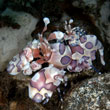And the difference? Prawns have sequentially overlapping body segments – segment one covers segment two, segment two covers segment three and so on. Their first three leg pairs are claws and their body shape, viewed side on, is curved. Shrimp also have overlapping segments but segment two overlaps segments one and three. Only their first two leg pairs are claws and their bodies have a distinctive bend.
For divers, shrimp are seen most. They come in an infinite variety of colours and patterns, which allows them to blend into reef hidey-holes. Whip corals, sea urchins, sea stars and anemones are excellent places to look for them.
Virtually all shrimp live in a commensal relationship with another species. One of the most fascinating is the relationship between Colman's Shrimp and the toxic fire urchin. Mantis shrimp stand out as having a distinct behavioural pattern. These solitary creatures are characterized by large raptorial appendages that are tucked beneath their heads. These are used as weapons that can strike a prey in three miliseconds and with a huge amount of power. Hence the two common varieties of mantis get nick-named thumbcrackers and spear chuckers. Be warned!


